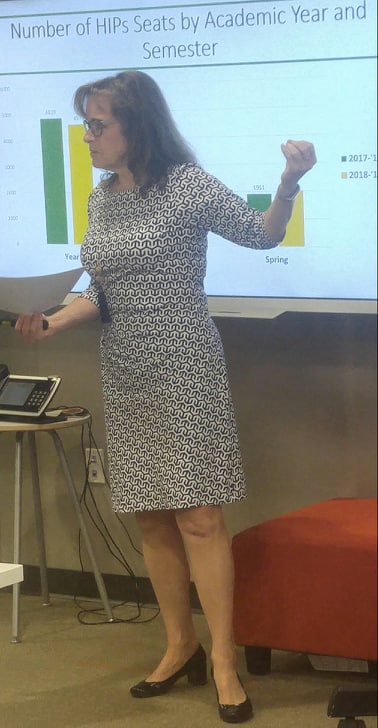By Jennifer Hoyt
William & Mary’s John Donahue and Janice Zeman found opportunity to communicate long-term planning goals that will shape the future of higher education within all departments and schools on campus. During the University Teaching Project’s workshop on April 3, they shared the latest research and vision behind the institution’s Quality Enhancement Plan (QEP), specifically the high impact practices that drive the plan. The instructional direction, referred to as HIPs, spiked interest in W&M faculty and learning partners as they considered their own curriculum and course design for upcoming semesters.

Educational Policy, shares facts
on QEP and High Impact
Practices with faculty and
learning partners.
“What we’ve been trying to do since 2016 is to increase the number [of students] in types of HIPs that support the learning outcomes of the QEP,” stated Donahue, W&M Dean of Educational Policy. He explained that the goals aim “to ensure students are aware of HIPs and to increase their participation in them.” Donahue noted that by making HIPs a focal point of W&M's Quality Enhancement Plan, the measurement of its success should naturally begin with the COLL curriculum as it narrows in on the skills and educational experiences of undergraduates. He also emphasized the academic significance of the plan as it serves as a requirement for the institution's SACS accreditation.
Moreover, Zeman presented details on student groups as they use HIPs to progress through their coursework. To break down the data, the dean of undergraduate studies offered comparisons between traditional and non-traditional students taken from both the 2017-2018 and 2018-2019 academic years. Focusing mainly on first-generation undergraduates and a combination of factors like race and ethnicity, she shared that the numbers will now serve as a clear guide for action.

Undergraduate Studies, shows
research results on student
enrollment and participation.
“This is the type of thing that we want to start seeing, increases in some of these categories, now that we have these all instituted and in place,” said Zeman. The dean of undergraduate studies also pointed to an ideal strategy to spread the word. “I think there are little ways that we can start messaging and teaching more about HIPs in our COLL 100 and 150 classes.”
Donahue agreed on the necessity for stronger communication of HIPs and W&M’s Quality Enhancement Plan overall, and he named advisors, departments, and learning centers as obvious receivers of information. Nonetheless, as the dean of educational policy recognized, messaging and implementation require money. “The funding thing is trickier,” he stated. “Not everybody can do study abroad. Not everybody can do some of the things that are more costly.”
Pivoting to other possibilities of integrating HIPs into course curriculum, Donahue suggested setting aside funds for tutoring and mentoring in hopes of reaching underrepresented student groups. Recognizing the 2022 deadline for submitting a progress report on W&M’s Quality Enhancement Plan, the dean stressed the exploratory approach to their research, along with maximizing HIPs and the academic opportunities available within higher education. “Anybody can count courses and submit a report, and we don’t want to stop there,” Donahue announced. “We really want to increase equity and access here and get a better representation of all the things students do here.”

